Low-NOx Burners: Powering the Green Industrial Revolution

Amid the dual pressures of climate change and environmental degradation, industries worldwide are undergoing a transformative shift toward sustainability. As the "heart" of energy-intensive sectors like petrochemicals, power generation, and metallurgy, combustion systems now face a critical mandate: balancing productivity with planetary health. Industrial low-NOx burners have emerged as a cornerstone technology—not merely reducing emissions, but redefining how industries harmonize with nature.
I. Nitrogen Oxides: An Invisible Threat to Ecosystems
Nitrogen oxides (NOx), byproducts of industrial combustion, are far more destructive than their invisibility suggests:
- Air Quality Saboteurs: NOx reacts with sunlight and volatile organic compounds (VOCs) to form ozone and PM2.5, the primary components of smog and respiratory hazards.
- Climate Accelerants: Nitrous oxide (N₂O), a NOx derivative, traps 265 times more heat than CO₂ and persists in the atmosphere for over a century.
- Silent Health Crisis: Chronic exposure to NOx is linked to asthma, lung damage, and cancer, prompting the WHO to classify it as a Group 1 carcinogen.
Globally, industrial combustion emits 25 million tons of NOx annually, with petrochemicals contributing over 30%. Traditional burners, even paired with costly scrubbers like Selective Catalytic Reduction (SCR), remain inefficient. Low-NOx burners disrupt this paradigm by attacking pollution at its source—preventing emissions rather than cleaning them up.

II. How Low-NOx Burners Rewrite Combustion Science
These burners achieve "clean flames" through radical engineering innovations:
Temperature Mastery
- Staged Combustion: Divides combustion into two zones—a low-oxygen "cool phase" (below 1,300°C) to suppress NOx formation, followed by a high-efficiency burnout stage.
- Flue Gas Recirculation (FGR): Recycles cooled exhaust to dilute oxygen, cutting NOx by 40–60% while stabilizing flame dynamics.
Precision Fuel-Air Chemistry
- Premixing Technology: Atomizes fuel and air into a homogeneous mixture before ignition, eliminating hotspots and slashing NOx by 70%.
- Catalytic Combustion: Coats burners with platinum-group metals, enabling complete fuel burnout at 600°C—half the temperature of conventional systems.
AI-Driven Intelligence
- Sensors and machine learning algorithms optimize air-fuel ratios in real time, maintaining NOx levels below 50 mg/m³ (EU’s strictest threshold) even during operational fluctuations.
Case in Point: A Chinese refinery retrofitted 32 heaters with low-NOx systems, reducing annual NOx emissions by 1,800 tons (equal to removing 120,000 gas-powered cars from roads) while saving $2.8 million in fuel costs through 8% efficiency gains.
III. Beyond Emissions: Cascading Environmental Benefits
The impact of low-NOx burners radiates far beyond smokestacks:
1.Ending the "Treatment Trap
- Traditional post-combustion scrubbing consumes 1.2 tons of toxic ammonia per ton of NOx removed, generating hazardous wastewater. Low-NOx burners reduce reliance on such methods by 60%, aligning with the "pollution prevention pays" principle.
2.Bridging the Energy Transition
- Hydrogen Compatibility: Next-gen burners seamlessly blend hydrogen with fossil fuels, enabling refineries to cut carbon footprints without overhauling infrastructure. A pilot ethylene plant using 30% hydrogen achieved 46,000 tons of annual CO₂ reductions.
- Biomass Integration: Supports carbon-neutral biofuels, accelerating industries toward circular economies.
3.Global Standard-Setting
- The EU’s Industrial Emissions Directive (IED) enshrines low-NOx burners as Best Available Techniques (BAT), forcing polluters to modernize or face penalties.
- Chinese innovators now export ultra-low-NOx models (<15 mg/m³) to developing nations, positioning green tech as a diplomatic tool.
IV. The Road to Zero-Impact Combustion
Emerging technologies promise to erase NOx entirely:
- MILD (Moderate and Intense Low-Oxygen Dilution): Achieves near-flameless combustion, slashing NOx below 5 mg/m³.
- Plasma Ignition: Ionizes fuel molecules to enable ultra-clean coal combustion, bridging the gap to renewable energy.
- Digital Twins: Virtual simulations predict and optimize burner performance before physical deployment, minimizing trial-and-error waste.
Conclusion: Redefining Industry’s Role in a Green World
Low-NOx burners symbolize a paradigm shift: industries no longer need to choose between profit and planet. By transforming combustion from a pollution source to a sustainability driver, this technology proves that heavy industry can be both economically viable and ecologically regenerative. As the UN Industrial Development Organization notes, "The factories of tomorrow will be judged not by their output, but by their oxygen."
In this era of climate urgency, every ton of NOx eliminated is a step toward breathable air, stable climates, and a livable future. The flame of innovation, once a symbol of environmental harm, now lights the path to planetary healing.
Join the Clean Combustion Movement
How is your industry tackling NOx challenges? Share your insights or questions below—let’s ignite a conversation for change!





